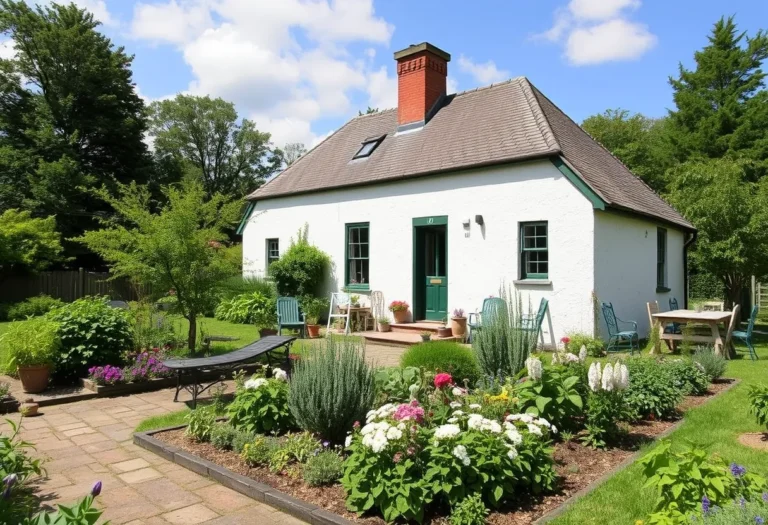Discover the Best States for Homesteading and Off-Grid Living
Self-sufficient living has never looked more attractive. People are leaving their city lives behind for the rewarding challenges of homesteading. The numbers tell the story – homestead-related searches have jumped 300% since 2020.
The best states for homesteading offer more than just affordable land. You need the right mix of climate, regulations, and resources that work together. We talked to successful homesteaders and analyzed data for months to figure out why some states work better than others.
You might be curious about homesteading possibilities in the United States or looking for states that match your needs. This piece walks you through everything from climate and water rights to property laws and community support. We’ve put together a complete guide that covers tax benefits and renewable energy options in the best US homesteading locations.

Essential Factors for Choosing Your Homestead State
The success of your homesteading depends on three significant factors that can make or break your experience. Let’s look at these vital elements that will help shape your decision.
Climate and Growing Season Considerations
Climate affects your knowing how to grow food and live sustainably. The growing season – the time between the last spring frost and first fall frost – changes by a lot across states. To cite an instance, states like Michigan give you four distinct seasons with rich, fertile soil. Maine’s longer, colder winters need special adaptation strategies to farm successfully.
These climate factors need your attention:
- Annual rainfall patterns and natural moisture sources
- Length of frost-free growing period
- Soil quality and natural fertility indicators
- Risk of natural disasters in the area
Water Rights and Access Requirements
Your homestead’s water access makes all the difference. Life without municipal water means you’ll need other sources like wells, natural water bodies, or rainwater collection. Each state’s water rights regulations differ. Some need permits to use surface water. Others have specific rules about groundwater extraction.
Property Laws and Zoning Regulations
Local zoning laws and building restrictions need a thorough check before you buy your homestead property. Some areas limit minimum square footage or don’t allow certain types of alternative housing. On top of that, many counties have their own rules about waste management systems and farming activities. To name just one example, see how some regions need at least 35 acres to qualify for a well permit.
Top States for Modern Homesteading
Modern homesteading has grown beyond traditional farming practices. Technology and sustainability are vital factors in picking the perfect location. Our research points to several states that lead this progress.
States with Progressive Sustainability Laws
State-level environmental protection shows promising signs. Montana, New York, and Pennsylvania now have constitutional rights to a healthy environment. Nine more states think over similar legislation. Hawaii, Nevada, and New Mexico expand their scope by adding rights to a stable climate in their proposed amendments.
Best States for Solar and Wind Power
Renewable energy has clear leaders in the United States. Texas leads wind power production and can supply over 6 million homes. Iowa comes in strong second place with wind energy that powers nearly 2 million homes. California stands alone as the only state that ranks in the top 5 for both solar and wind energy.
Tech-Friendly Homesteading Communities
Tech-savvy homesteading communities bring excitement to the field. These modern settlements blend self-sufficiency with smart technology. Here’s what we found in these communities:
- Smart meters that monitor energy use in real time
- Cloud-based shared planning tools to manage community resources
- Satellite communication systems that ensure reliable internet access
- Advanced solar and wind power integration with smart inverters
California and Oregon lead the way as pioneers. These states promote communities that welcome green practices and technological breakthroughs. People who want to mix traditional homesteading with modern conveniences will find unique opportunities here.
Financial Aspects of State Selection
Smart state selection can substantially affect your homestead’s long-term success in the financial world. Let’s look at the vital money matters that could help you pick the best states for homesteading.
Property Tax Comparisons
Property tax rates vary greatly between states. Illinois ranks among states with the highest property taxes. Alabama proves more wallet-friendly with its cost of living index of 89.3. Your choice of homestead location in the United States should take these tax factors into account:
- Annual property tax rates
- Special agricultural zoning benefits
- Local tax assessment methods
- Rural vs. urban tax differences
Homestead Exemption Benefits
The homestead exemption programs are a great way to get tax advantages in several states. Georgia’s tax breaks for agricultural land use stand out from the rest. Alabama’s homeowners can qualify for exemptions up to $4,000 in assessed value. Georgia offers a simple $2,000 exemption from county and school taxes.
Cost of Land Analysis
Land prices for homesteading show dramatic variations. Quality farmland in desirable areas costs between $8,000 and $15,000 per acre. Less ideal but workable land ranges from $1,500 to $3,000 per acre. Missouri emerges as one of the most affordable options with its cost of living index of 87.1.
Foreign ownership has pushed land prices higher. Foreign entities now own nearly 30 million acres of U.S. land. Chinese investments in the agricultural sector have grown tenfold over the last several years. This trend affects prices most notably in Maine and Texas, which have the highest levels of foreign land ownership.
Building Your Homestead Support Network
Location isn’t the only factor in homesteading success – building a strong support network matters just as much. Successful homesteaders depend on their communities, both online and offline, to share knowledge and resources.
Finding Local Homesteading Communities
Local homesteading groups are growing rapidly in the best states to homestead. States like California (8.8%), Virginia (6.5%), and Alabama (6.4%) now have the highest numbers of active homesteaders. These local communities offer several key benefits:
- Knowledge sharing and practical support
- Equipment sharing opportunities
- Local market connections
- Mentorship from experienced homesteaders
- Crisis support during challenging times
Agricultural Extension Services
The Cooperative Extension System (CES) stands out as a valuable resource that operates through the nation’s Land-Grant University System. These services have offices near most of the nation’s 3,000 counties and provide great support through:
Research-based guidance for farming and livestock management Hands-on workshops and educational seminars Access to university faculty experts Local soil testing and analysis services

Online Resources by State
Modern homesteading blends traditional wisdom with smooth digital connections. Many states’ extension offices now offer complete online resources, with Michigan, Oregon, and Idaho leading the way with strong digital support networks. These platforms give you everything from seasonal planting guides to local regulations and community forums.
The best states for homesteading each have their own advantages, but your success often depends on how well you use these support networks. Homesteaders who participate in their local communities and extension services adapt faster to challenges and find creative solutions to common problems.
Conclusion
Homesteading is more than a lifestyle change – it’s your path to self-sufficiency that needs smart planning and the right location. Our research shows dramatic differences between states in their homesteading potential. Everything matters – from climate conditions and growing seasons to property laws and community support.
The ideal states for homesteading blend affordable land, friendly regulations, and supportive networks. Montana and Texas stand out with their forward-thinking sustainability laws and renewable energy options. Some states excel by providing agricultural extension services and tech-savvy communities.
Getting a full picture of your chosen state’s characteristics will determine your success. You need to think over growing seasons, water rights, property taxes, and available exemptions. The cheapest land isn’t always your best choice. Soil quality, rainfall patterns, and community resources play significant roles in your long-term success.
Your homestead’s success depends on strong support networks. States with active homesteading communities and agricultural extension services are a great way to get resources for newcomers and seasoned homesteaders alike. These connections can transform your journey from a solo struggle to achieving a sustainable homestead.
FAQs
Q1. Which states are most suitable for off-grid homesteading? Alaska, Tennessee, Washington, Montana, and Wyoming are often considered ideal for off-grid living due to their abundant natural resources, favorable regulations, and diverse landscapes that support self-sufficient lifestyles.
Q2. What factors should I consider when choosing a state for homesteading? Key factors include climate and growing season, water rights and access, property laws and zoning regulations, property taxes, homestead exemption benefits, and the availability of local homesteading communities and support networks.
Q3. Are there states with less restrictive regulations for off-grid living? Some states, like Montana, have more relaxed regulations for off-grid living. However, regulations vary by county and locality, so it’s essential to research specific area requirements for permits, building codes, and utility connections.
Q4. Which states offer the most affordable land for homesteading? States like Arizona, New Mexico, Colorado, Missouri, and Oregon often have more affordable farmland. However, land prices can vary significantly within each state, and it’s important to consider factors beyond just cost, such as soil quality and water access.
Q5. How important is community support for successful homesteading? Community support is crucial for homesteading success. States with active homesteading communities, robust agricultural extension services, and online resources provide invaluable knowledge sharing, practical support, and networking opportunities that can significantly enhance your homesteading experience.






